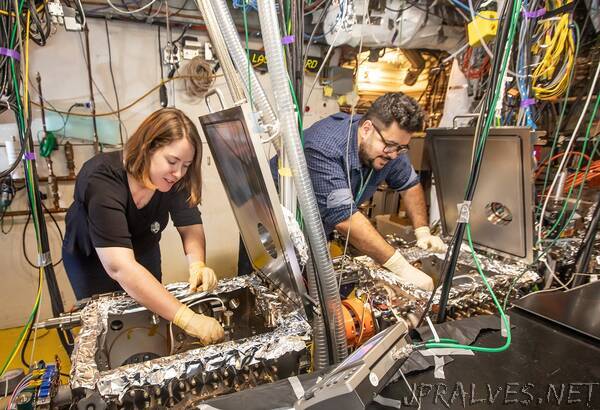
“Researchers have squeezed a high-energy electron beam into tight bundles using terahertz radiation, a promising advance in watching the ultrafast world of atoms unfold.
Researchers from the Department of Energy’s SLAC National Accelerator Laboratory have made a promising new advance for the lab’s high-speed “electron camera” that could allow them to “film” tiny, ultrafast motions of protons and electrons in chemical reactions that have never been seen before. Such “movies” could eventually help scientists design more efficient chemical processes, invent next-generation materials with new properties, develop drugs to fight disease and more.
The new technique takes advantage of a form of light called terahertz radiation, instead of the usual radio-frequency radiation, to manipulate the beams of electrons the instrument uses. This lets researchers control how fast the camera takes snapshots and, at the same time, reduces a pesky effect called timing jitter, which prevents researchers from accurately recording the timeline of how atoms or molecules change.
The method could also lead to smaller particle accelerators: Because the wavelengths of terahertz radiation are about a hundred times smaller than those of radio waves, instruments using terahertz radiation could be more compact.
The researchers published the findings in Physical Review Letters on February 4.
A Speedy Camera
SLAC’s “electron camera,” or ultrafast electron diffraction (MeV-UED) instrument, uses high-energy beams of electrons traveling near the speed of light to take a series of snapshots – essentially a movie – of action between and within molecules. This has been used, for example, to shoot a movie of how a ring-shaped molecule breaks when exposed to light and to study atom-level processes in melting tungsten that could inform nuclear reactor designs.
The technique works by shooting bunches of electrons at a target object and recording how electrons scatter when they interact with the target’s atoms. The electron bunches define the shutter speed of the electron camera. The shorter the bunches, the faster the motions they can capture in a crisp image.
“It’s as if the target is frozen in time for a moment,” says SLAC’s Emma Snively, who spearheaded the new study.
For that reason, scientists want to make all the electrons in a bunch hit a target as close to simultaneously as possible. They do this by giving the electrons at the back a little boost in energy, to help them catch up to the ones in the lead.
So far, researchers have used radio waves to deliver this energy. But the new technique developed by the SLAC team at the MeV-UED facility uses light at terahertz frequencies instead.
Why terahertz?
A key advantage of using terahertz radiation lies in how the experiment shortens the electron bunches. In the MeV-UED facility, scientists shoot a laser at a copper electrode to knock off electrons and create beams of electron bunches. And until recently, they typically used radio waves to make these bunches shorter.
However, the radio waves also boost each electron bunch to a slightly different energy, so individual bunches vary in how quickly they reach their target. This timing variance is called jitter, and it reduces researchers’ abilities to study fast processes and accurately timestamp how a target changes with time.
The terahertz method gets around this by splitting the laser beam into two. One beam hits the copper electrode and creates electron bunches as before, and the other generates the terahertz radiation pulses for shortening the electron bunches. Since they were produced by the same laser beam, electron bunches and terahertz pulses are now synchronized with each other, reducing the timing jitter between bunches.
Down to the femtosecond
A key innovation for this work, the researchers say, was creating a particle accelerator cavity, called the compressor. This carefully machined hunk of metal is small enough to sit in the palm of a hand. Inside the device, terahertz pulses shorten electron bunches and give them a targeted and effective push.
As a result, the team could compress electron bunches so they last just a few tens of femtoseconds, or quadrillionths of a second. That’s not as much compression as conventional radio-frequency methods can achieve now, but the researchers say the ability to simultaneously lower jitter makes the terahertz method promising. The smaller compressors made possible by the terahertz method would also mean lower cost compared to radio-frequency technology.
“Typical radio-frequency compression schemes produce shorter bunches but very high jitter,” says Mohamed Othman, another SLAC researcher on the team. “If you produce a compressed bunch and also reduce the jitter, then you’ll be able to catch very fast processes that we’ve never been able to observe before.”
Eventually, the team says, the goal is to compress electron bunches down to about a femtosecond. Scientists could then observe the incredibly fast timescales of atomic behavior in fundamental chemical reactions like hydrogen bonds breaking and individual protons transferring between atoms, for example, that aren’t fully understood.
“At the same time that we are investigating the physics of how these electron beams interact with these intense terahertz waves, we’re also really building a tool that other scientists can use immediately to explore materials and molecules in a way that wasn’t possible before,” says SLAC’s Emilio Nanni, who led the project with Renkai Li, another SLAC researcher. “I think that’s one of the most rewarding aspects of this research.”
This project was funded by DOE’s Office of Science. The MeV-UED instrument is part of SLAC’s Linac Coherent Light Source, a DOE Office of Science user facility.
Citation: E. C. Snively et al., Physical Review Letters (10.1103/PhysRevLett.124.054801)”
